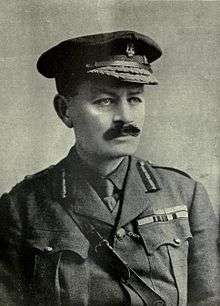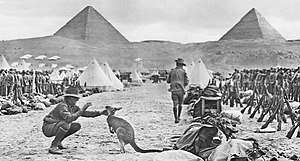Force in Egypt
The Force in Egypt was a British Army formation established in August 1914 to administer garrisoning armed forces in Egypt at the beginning of the First World War. The force had the objective of protecting the Suez Canal and was originally commanded by Major General Julian Byng,[1] but he was replaced by General J. Maxwell, who took command on 8 September 1914.[2] Initially, the main threat to the Suez came from Germany and throughout the early months several of the force's elements were sent to Europe to take part in the fighting on the Western Front. On 5 November 1914, Britain and France declared war on the Ottoman Empire,[3] after which the Force in Egypt faced a direct threat from Ottoman forces, which was realised in February 1915 with a raid on the Suez Canal. This threat remained until 1916 when the British forces went on the offensive.

| Principal battles of the Force in Egypt |
| 1915: Defence of the Suez Canal |
The composition of the force changed several times due to the varying availability forces. By the end of 1914, the forces deployed in defence of the Suez Canal under Maxwell totaled approximately 30,000 troops. The main elements of this force were the 10th Indian Division (Major General A. Wilson), the 11th Indian Division, the Imperial Service Cavalry Brigade, and the Bikaner Camel Corps, as well as elements from the Indian Mountain Artillery and the Egyptian Army Artillery. In addition, several British and French warships in the canal served as floating batteries and there were several aircraft available for reconnaissance.[4] Following the opening of the Gallipoli Campaign, the Force in Egypt was reduced mainly to a training and reinforcement camp until forces were withdrawn from the Gallipoli Peninsula and returned to Egypt in December 1915.
In 1916, the Force in Egypt was merged with the Mediterranean Expeditionary Force to form the Egyptian Expeditionary Force (EEF).[5] General Sir Archibald Murray was given command and additional resources and the mission of the EEF changed from the defence of the Suez to an invasion of Palestine.[6]

August 1914
- 3rd Dragoon Guards
- T Battery, Royal Horse Artillery
- 7th Mountain Battery, Royal Garrison Artillery
- 2nd Field Company, Royal Engineers
- 2nd Battalion, Devonshire Regiment
- 1st Battalion, Worcestershire Regiment
- 2nd Battalion, Northamptonshire Regiment
- 2nd Battalion, Gordon Highlanders and auxiliary services.[7]
September 1914
In addition to the above, two units from the 3rd (Lahore) Division were added:
- 9th (Sirhind) Brigade
- III Mountain Artillery Brigade
Shortly afterwards, as a result of the Sinai frontier being crossed, Lord Kitchener ordered additional forces in the form of the East Lancashire Division (Territorial Force) with two Yeomanry regiments to follow, although several elements that were assigned to the Force in Egypt in August 1914 were shipped to France.[8]
By October 1914, the 9th (Sirhind) Brigade was under orders to deploy to France but was retained until the 22nd (Lucknow) Brigade arrived.[9]
The following forces were promised and on their way to Egypt in October 1914:
- Bikanir Camel Corps
- Imperial Service Cavalry Brigade
- 32nd (Imperial Service) Brigade
- 33rd Punjabis battalion (regular British India Army)
- Alwar, Gwalior and Patiala Infantry battalions
- eight Indian battalions
- three more Indian brigades.[9]
January 1915

(total force 70,000)
- 10th Indian Division
- 11th Indian Division
- Imperial Service Cavalry Brigade
- Bikanir Camel Corps
- Indian Mountain Artillery (three batteries)
- Egyptian Army Artillery (one battery)
- Royal Flying Corps detachment
- French naval seaplanes
In training
- Australian and New Zealand Army Corps (ANZAC)
- 42nd (East Lancashire) Division [10][11]
Suez Canal Defences: 15 January 1915
- Advanced Ordnance Depot Zagazig
- one battalion from the 32nd (Imperial Service) Brigade
- Garrison railway and Sweetwater Canal
- one troop of Imperial Service Cavalry
- a half company from the Birkanir Camel Corps
- a half company of Indian infantry
- General Reserve Camp, Moascar
- 31st Indian Brigade
- 2nd Queen Victoria's Own Rajput Light Infantry
- 27th Punjabis
- 93rd Burma Infantry
- 128th Pioneers
- 32nd (Imperial Service) Brigade
- 33rd Punjabis
- Alwar, Gwalior and Imperial Service Cavalry Brigade less three squadrons and one troop
- one Egyptian RE Section (camels)
- one Egyptian Mountain Battery
- two sections of field artillery with the Cavalry Brigade
- Indian field ambulances.[12]
- 31st Indian Brigade
Sector I: Port Tewfik to Geneffee
- Headquarters at Suez
- 30th Indian Brigade
- 24th Punjabis
- 76th Punjabis
- 126th Baluchis
- 2/7th Gurkha Rifles
- one squadron of Imperial Service Cavalry
- one company from the Birkanir Camel Corps
- half company of Sappers and Miners
- one battery from the Royal Field Artillery (Territorial)
- one Indian field ambulance
Sector II: Deversoir to El Ferdan
- Headquarters at Ismailia Old Camp
- 22nd (Lucknow) Brigade
- 62nd Punjabis
- 92nd Punjabis
- 2/10th Gurkha Rifles
- 28th Indian Brigade
- 51st Sikhs
- 53rd Sikhs
- 56th Punjabis
- 1/5th Gurkha Rifles
- one squadron Imperial Service Cavalry
- the Birkanir Camel Corps (less three and a half companies)
- a machine gun section from the Egyptian Camel Corps
- one battery from the Royal Field Artillery (Territorial)
- one battery from the Indian Mountain Artillery
- two Indian field ambulances
Sector III: El Ferdan to Port Said
- Headquarters El-Qantarah
- 29th Indian Brigade
- 14th Sikhs
- 69th Punjabis
- 89th Punjabis
- 1/6th Gurkha Rifles
- one battalion from the 22nd (Lucknow) Brigade
- one squadron from the Imperial Service Cavalry
- two companies from the Birkanir Camel Corps
- half company of sappers and miners
- two batteries from the Royal Field Artillery (Territorial)
- 26th Battery, Indian Mountain Artillery
- armoured train with a half company of Indian infantry
- wireless section (Territorial)
- Indian field ambulance
- Detachment Royal Army Medical Corps (Territorial)[13]
April 1915
During April the 29th Indian Brigade and the East Lancashire Division were sent to Gallipoli. The 2nd Mounted (Yeomanry) Division arrived to take their place by 29 April.[14]
Sent to Gallipoli as part of the Mediterranean Expeditionary Force
- ANZAC Corps
- 42nd (East Lancashire) Division
- one Indian brigade (incomplete)
Sent to Basra
- one Indian brigade
Sent to Aden (to defend Yemen against a possible attack)
9 July 1915
The total force of 69,765 personnel consisted of:
- one Yeomanry brigade: 1,054 personnel
- 2nd Mounted Division: 8,242 personnel
- Indian Expeditionary Force "E" (under orders for Aden): 15,940 personnel
- 5th, 6th, 7th Australian Brigades in process of arriving: 5,212 personnel
- ANZAC: 10,243 personnel
- 29th Divisional Supply Column: 312 personnel
- regulars, details, depot: 829 personnel
- Mediterranean Expeditionary Force base: 28,134 personnel[17]
By November 1915, the Force in Egypt had been reduced largely to a training and reinforcement camp. Although there were 60,000 troops in Egypt, these were mainly details of formations fighting at Gallipoli and ANZACs in training.[18]
November 1915
Western Frontier Force (Major General A. Wallace)
- Composite mounted brigade
- Three composite regiments of Yeomanry
- One composite regiment of Australian Light Horse
- 1/1st Nottinghamshire Royal Horse Artillery
- Composite infantry brigade
- Three territorial battalions.
- One battalion Indian infantry (15th Sikhs).
Some South African troops and a New Zealand battalion were added after November 1915.[19]
On 10 March 1916, the Force in Egypt was merged with the Mediterranean Expeditionary Force to form the Egyptian Expeditionary Force.[5]
Notes
- Falls 1930 Vol. 1 p. 11
- Falls p. 14
- Falls 1930 Vol. 1 p. 16 note
- Bruce 2002, pp. 15–6
- Falls 1930 Vol. 1 pp. 96–7
- Woodward, David (March 10, 2011). "The Middle East During World War I". BBC History. BBC. Retrieved 21 October 2014.
- Falls 1930 Vol. 1 p. 11 note
- Falls 1930 Vol. 1 p. 14
- Falls 1930 Vol. 1 p. 15
- Carver 2003, pp. 8–9
- Wavell 1968, p. 27
- Falls 1930 Vol. 1 pp. 32–3
- Falls 1930 Vol. 1 pp. 31–2
- Falls 1930 Vol. 1 p. 57
- Coulthard-Clark 1998, p. 22
- Wavell 1968, p. 34
- Falls 1930 Vol. 1 p. 68
- Falls 1930 Vol. 1 p. 85
- Wavell 1968, pp. 36–7
References
- Bruce, Anthony (2002). The Last Crusade: The Palestine Campaign in the First World War. London: John Murray. ISBN 978-0-7195-5432-2.
- Carver, Michael, Field Marshal Lord (2003). The National Army Museum Book of the Turkish Front 1914–1918: The Campaigns at Gallipoli, in Mesopotamia and in Palestine. London: Pan Macmillan. ISBN 978-0-283-07347-2.
- Coulthard-Clark, Chris (1998). Where Australians Fought: The Encyclopaedia of Australia's Battles. St Leonards, New South Wales: Allen and Unwin. ISBN 1864486112.
- Falls, Cyril; G. MacMunn (1930). Military Operations Egypt & Palestine from the outbreak of war with Germany to June 1917. Official History of the Great War Based on Official Documents by Direction of the Historical Section of the Committee of Imperial Defence. 1. London: HM Stationery Office. OCLC 610273484.
- Wavell, Field Marshal Earl (1968) [1933]. "The Palestine Campaigns". In Sheppard, Eric William (ed.). A Short History of the British Army (4th ed.). London: Constable & Co. OCLC 35621223.